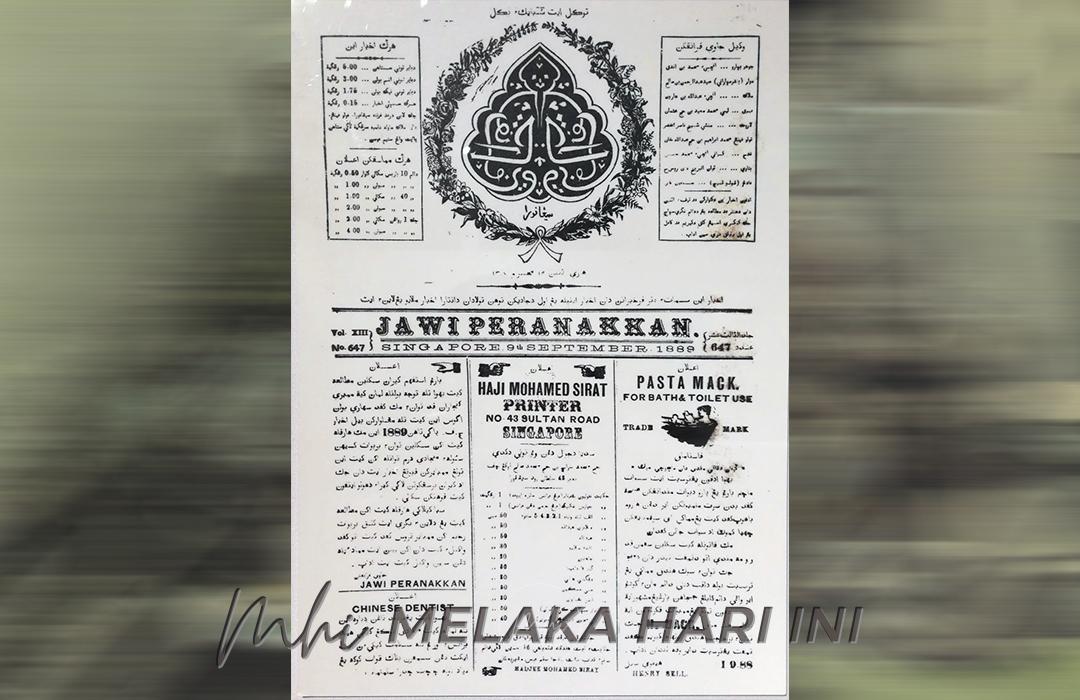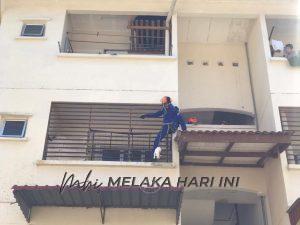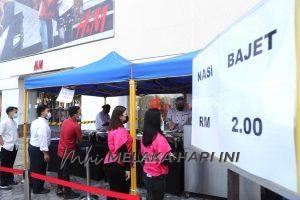
The Jawi Peranakan: Early Popular Expressions of Malay Identity in the Archipelago
The newspaper Jawi Peranakan (1876 – 1895), the first Bahasa Melayu periodical in Malaysia grew from the enterprise of the Jawi Peranakan community. It was a weekly, published every Monday. Its printer was Matba’ ‘Al-Saidi (percetakan Muhammad Said), at number 431, Victoria Street (Kampung Gelam), in Singapura.
Interestingly the four-paged newspaper carried the slogan “Tawakal itu sebaiknya bekal” (Trust in God as a Provision). Considered to be the first Bahasa Melayu newspaper in the Straits Settlements and the Malay States, the periodical was a natural extension of Malays, especially in port cities – also refered to as Jawi Pekan (literally town Malays).
At that time, especially in places like Singapura and Pulau Pinang, there was the conscious emergence of a new, hybridzed identity as a result of the intermarriage between South Indian Muslim men, mainly Tamils and Malabaris, to Malay women. Not entirely new rather. Over at least two millenia, there has been waves of movements from both the Coromandel and the Malabar Coasts of India arriving at the shores of the Malay Peninsular, especially on the west coast, forming communities and cultures that would subsequently be assimilated into the dominant Malay malay identity. And to be fair, it was not only a one-way traffic.
Historian William R. Roff (1972) emphasized the significance of recognizing that the Jawi Peranakan thinking of themselves as Malays. The newspaper Jawi Peraanakan identified entirely with Malay interests, speaking always of “we Malays” or “this Malay community” and primarily reporting Malay affairs. The editors and journalists wrote as Malays.
Nowadays, in Malaysia, the identity and self-conciousness of the community is mainly concentrated in Tanjong, the rest of Pulau Pinang and the urban, western plains of Kedah. And any soul in the nation who has that identity consciousness in them. I have also interchangeably used the term “Melayu Tanjong.”
Jawi Peranakan, was the longest lived Bahasa Melayu newspaper in modern Malaysia. Prior to 1941, it appeared for 19, some said 20 years. There was certainly a reading public, an audience, and a culture of social and intellectual consumption.
We do not find much of these narrated in history but its appearance, together with several other periodicals, made possible by publishers and printers, especially in Singapura and Pulau Pinang showed the intertwining relations between journalism, the printing of periodicals, economic and business transactions, as well as cultural and political expressions of the group. The weekly was generaly well-received by the Malay, Jawi Peranakan, Arab and the Arab Peranakan communities in the region.
The Jawi Peranakan, further manifested the prosperity and intellectual dynamism of the group in the throes of rapid change with the entrance of European influence. It was a reponse toward Westernization. The group had in the period, expressed these as grave concerns.
As such the Jawi Peranakan association was formed in Singapura in 1876. They brought a printing press, and launched the weekly the same year. It provided the latest foreign and local and foreign news, fostered vernacular education and helped to give some regularity to the changing Malay language.
The Jawi Peranakan is cosmopolitan in outlook and regional in its circulation and readership. It reported and commented on the circumstances of their lives. The periodical relied on the English-langiuge press in the Straits Settlements for much of their materials. It came increasingly to style itself after the Eqyptian and Arabic press for news and opinion. The editors and journalists behind the weekly wrote as Malays and were not bounded by genres and traditions.
It fostered a knowledge of the Malay world and a sense of community. It had representatives from various parts of the Malay Archipelago, The wakil, or correspondents were placed in such places as Medan, Deli, Padang and Singkel in Sumatera, Riau and Sarawak. There were also stories from Sandakan and Patani, the latter describing the system of government and conditions of its inhabitants. There was also a letter from Labuan on the values of newspapers. Jawi Peranakan embodied the geography of Malay world cosmopolitanism.
Generally the practice of news exchange became common place between Jawi Peranakan and several Java-based newspapers like Selompret Melajoe, Bintang Barat Hindia-Nederland. Apart from general correpondences and letters to the editor, the weekly also printed advertisements, as well as publicised prices of commodities such as tin, black pepper, white pepper, clove and sago.
Jawi Peranakan brought together a general consciousness of the Malay world. The newspaper’s first editor was Munsyi Muhammad Said bin Dada Muhyiddin. Born in Pulau Pinang, he was educated in Kedah by a hakim (an intelligent or wise person) who was a scribe to the Sultan of Kedah.
According to Ahmat Adam (1992), Munsyi Muhammad Said was familiar with places such as Aceh Deli, Serdang, Batu Bara, Asahan, and the Malay states of Perak, Selangor, Pahang and Terengganu through his contacts and travels. He was a familar name to colonial officials and the Malay rulers.
The weekly was initially sold for 30 cents per copy, but subsequenty reduced to 15 cents after a decade of publication. He managed and led Jawi Peranakan until his death in 1888. He also taught at the Raffles Institution in Singapura.
NEXT WEEK: “A Kedah Island”
Prof. Dato’ Dr. Ahmad Murad Merican is Professor of Social and Intellectual History with the International Institute of Islamic Tho ught and Civilization, International Islamic University (ISTACIIUM). He is a Senior Fellow with the Southeast Asia Research Centre and Hub at De La Salle University, Manila, the Philippines.


